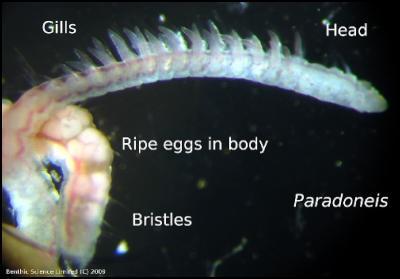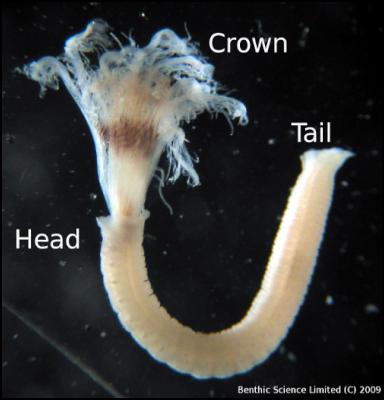Sandflat surprises
Sandflat surprises
by Brian Paavo
Consider Blueskin Bay as you look out your window, walk along the shore, fossick for cockles, or simply breathe in the ambiance. It's a magic place to live and work whether the sandflats are in the forefront of your working day or the background of your life. At a glance the sandflat may look static, but it is really a six square kilometre expanse of dynamic animal communities. They're just a little shorter and easily overlooked! These communities churn through the seasons relentlessly, but they hold surprises that few suspect, even species new to science!

The large Waitati River catchment channels rainwater, sediments, vegetation, and pollutants from cloud forests, scrub patches, pastures, a highway, and home gardens into the inlet. Everything that people, plants, and animals leave behind heads for the sea, and in this corner of the world, the denizens of Blueskin Bay serve as the recyclers and gatekeepers to the ocean. Most people see the birds and fish of the inlet. Many are familiar with the cockles that nestle in the sand and breathe in each tide, but our team has recently had the privilege to look a little closer at some of the real movers and shakers among the inlet animals.
The Project
In mid-2009 Chorus (a separate division of Telecom New Zealand) contacted us to investigate the likely ecological impacts of operations required to lay a fibre-optic cable across the inlet to provide reliable telephone and internet access to Warrington residents. Brendan Flack of the East Otago Taipure Management Committee (EOTMC) and Chris Hepburn from the University of Otago had requested that Chorus, through Mitchell Partnerships, evaluate the likely impacts to the broader animal ecology of the inlet, not just the cockle beds which had been examined previously. The original cable path proposal had already been extended to avoid negative impacts to seagrass areas and cockle beds. Many of you probably heard of the general operation in a flyer distributed by Chorus or media articles in July (for example http://blueskin-co-nz.blogspot.com/2009/07/cable-laying-proposal-in-blueskin-bay.html). The full details of our findings should be freely available from Chorus soon.
We started our study by walking along the proposed cable path with Brendan (EOTMC) and Jim Fyfe from DOC. We took photographs of the different habitats we observed in the 1.5 square km study area. We then selected 14 sites and collected 42 core samples in August. Our methods focused on collecting animals larger than 1 mm in any dimension living in the top 150 mm of sand and mud.

The
Multitudes
We found over 6,000 animals in our samples, belonging to more than 60 species. Our estimates indicate that there are probably closer to 80 species of animals this size living in the sands of the inlet. The most numerous and species-rich kind of animals were polychaete (bristle) worms. If you pull up a handful of sand during low tide just about anywhere in the inlet, you'll probably see red, orange, or green worms living in tubes, these are mostly polychaetes. Just like worms in your garden, most polychaetes burrow through the sediment bringing buried nutrients up to the surface, and oxygen down to other animals. Without this process constantly turning over the inlet, the sandflats would be a black stinking expanse of bacteria-rich goo with far too much trash hanging around, few fish, and even fewer birds and cockles. Most polychaetes specialise in their inlet jobs. Some are predators, others skim food from the sediment surface, while others mine deep. All play a role recycling nutrients and providing food for larger animals in the inlet.
Although there were 60+ species in our samples, over 85% of the animals belonged to one of only ten species. The single most numerous find (2,171 individuals) was a species of polychaete that hasn't been described before anywhere in the world. It is closely related to a group of ten species known in New Zealand called Paradoneis (family Paraonidae), but the Waitati species has a set of new features. The closest descriptions come from an animal found only in deep water off of northern Europe. Not a likely match!
The Waitati Inlet Paradoneis is about 1 mm wide and up to a few centimetres long. Many of the animals collected in August had their bodies full of salmon-pink eggs. These animals have red blood like us, as can be seen in the photo below. They have a simple cone shaped head which is three-quarters nose and about 14 pairs of gills along their back. Without a microscope the bristles on their paddle shaped 'feet' look like simple hairs, but on closer inspection they turn out to be special bristles (chaetae) which are shaped like those funny pickle forks you see at dinner parties. The back end of the worm also means business - the hairs become stout spikes for a dozen segments in front of the worm's three 'tails'.
Although we don't know much about this particular species, other worms in the same family are known to feed on bacteria growing on sand grains and diatoms that form much of the brown 'scum' on top of Blueskin Bay sediments. In our study area, there was an average of 6,656 of these worms per square metre forming a miniature army of grazers and recyclers.
Paradoneis is not alone in this maintenance job. A smaller worm, only a few millimetres long and half a millimetre wide, was another polychaete found in half of our samples. It belongs to a family of 'feather-duster' polychaete worms called Sabellidae. Feather-dusters have a delicate crown on their head which they use as gills and filters. The inlet species may belong to the genus Chone, but more research is required to be certain. It's important to find out if it does belong to the genus Chone, because this genus has not been recorded anywhere in New Zealand before. Unlike Europe and America, there are lots of New Zealand species that have yet to be described and we know very little about what role they play in the environment. This delicate species has green blood and lives only on the very surface of the sediments sweeping its broom-shaped head back and forth in the mud. It picks out only those particles tasty enough and of the right size to eat.
The final star on our inlet worm safari is the largest worm you are likely to see in a handful of inlet sand. Two or three mm thick and 10 - 40 mm long, the bamboo worm (with the long name Macroclymenella stewartensis) was originally described from Stewart Island, but is now known to live in sheltered waters along much of the South Island. They use their reinforced, bulldozer-like head to push deep into the black mud swallowing sand and digesting the good bits. Their tubes stabilise the sand in storms, form homes for smaller animals, and act as pipes which bring oxygen tens of centimetres into the sediment as their powerful throats pump water and mud to the surface. Macroclymenella has a pretty, tulip-shaped bum that was often observed to be regrowing after getting nipped off by fish, birds, crabs, or other inlet predators.
What's Next?
Every one of the 60+ small animal species in the inlet plays its part in the healthy functioning of the inlet ecosystem. This diverse and abundant mini-wilderness is necessary to the survival of the larger animals that we appreciate every day. Even more importantly, they shape and stabilise the inlet in ways that we are only beginning to appreciate.
Thanks to the survey work supported by Chorus, we now know more about the life within the inlet than we did before, but what's next? There are more discoveries to make than there are adventurous scientists or funds to make them! Does the Waitati Paradoneis live elsewhere? We haven't seen it in Otago Harbour nor Papanui Inlet, but the only way to find out is to go and look in similar habitats nearby. Is Chone a new record for New Zealand? Did they hitch a ride to New Zealand recently or are these species native? Right now our team is looking through some samples from the early 90s to see if these animals might have been here then. Even the Waitati Paradoneis may remain unknown beyond Otago. It takes anywhere from $4,000 to $8,000 to describe a new species and few opportunities exist to fund such fundamental science. It is a sadly common story that we have only begun to peek into the inner workings of our own backyard before financial limitations stop us from further exploration. We encourage everyone to learn more about the organisms with which we share this planet and ask you to urge your councils and representatives to support basic research into the places and creatures that shape our lives.
(Brian Paavo PhD of Benthic Science Limited ends


 Natural Hazards Commission: Hub Launched To Empower Architects And Engineers To Build Above Code
Natural Hazards Commission: Hub Launched To Empower Architects And Engineers To Build Above Code Harmony Energy: Ceremony Heralds Start Of Construction On New Zealand’s Largest Solar Farm Project
Harmony Energy: Ceremony Heralds Start Of Construction On New Zealand’s Largest Solar Farm Project Stats NZ: Annual Number Of Home Consents Down 7.4 Percent
Stats NZ: Annual Number Of Home Consents Down 7.4 Percent Plains Media: Plains FM Announces Name Change After 37 Years
Plains Media: Plains FM Announces Name Change After 37 Years NIWA: Flooding From Underneath - New Tool Reveals Shallow Groundwater Elevations
NIWA: Flooding From Underneath - New Tool Reveals Shallow Groundwater Elevations Commerce Commission: Commission Concludes Auckland Airport Over-charging By $190 Million
Commerce Commission: Commission Concludes Auckland Airport Over-charging By $190 Million



